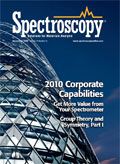Market Profile: Process FT-NIR
Fourier transform–near infrared (FT-NIR) spectroscopy is one of a number of molecular spectroscopy techniques that are already used for online process analysis across a number of industries, but are still seeing significant growth in demand. FT-NIR technology has a number of inherent advantages for online analysis.
Fourier transform–near infrared (FT-NIR) spectroscopy is one of a number of molecular spectroscopy techniques that are already used for online process analysis across a number of industries, but are still seeing significant growth in demand. FT-NIR technology has a number of inherent advantages for online analysis.

Process FT-NIR demand by industry in 2009.
The combination of the FT analysis method and the NIR spectrum combine to make FT-NIR a very useful online analytical tool. The use of the FT technique allows for instantaneous analysis of the entire spectrum of a broadband light source, rather than having to scan across the spectrum of interest or use only a single point of the electromagnetic spectrum for analysis. This is ideal for providing detailed analytical information of continuously flowing or changing processes. Although not as sensitive as mid-IR spectroscopy, NIR spectroscopy allows for deeper penetration of the sample, and is better for bulk materials.
Online FT-NIR is used most heavily in refineries and general chemical facilities due to its strength in the analysis of petrochemical compounds. A rapidly growing niche is in the development of alternative biofuels. The global market for process FT-NIR is well over $20 million annually, and is expected to see mid-to-high single-digit growth.
The foregoing data was based upon SDi's Market Analysis & Perspectives (MAP) report program. For more information, contact Stuart Press, Senior Consultant, Strategic Directions International, Inc., 6242 Westchester Parkway, Suite 100, Los Angeles, CA 90045, (310) 641-4982, fax: (310) 641-8851, www.strategic-directions.com.
Market Profile: Mass, Molecular, and Atomic Spectroscopy
December 1st 2018Mass spectrometry, molecular and atomic spectroscopy technologies combine to represent more than a fifth of the overall market for laboratory analytical instrumentation. These techniques are perhaps the most broadly used instruments, with utility in pharmaceuticals and other life sciences, chemicals, environmental, food, clinical/Dx and other applications.
